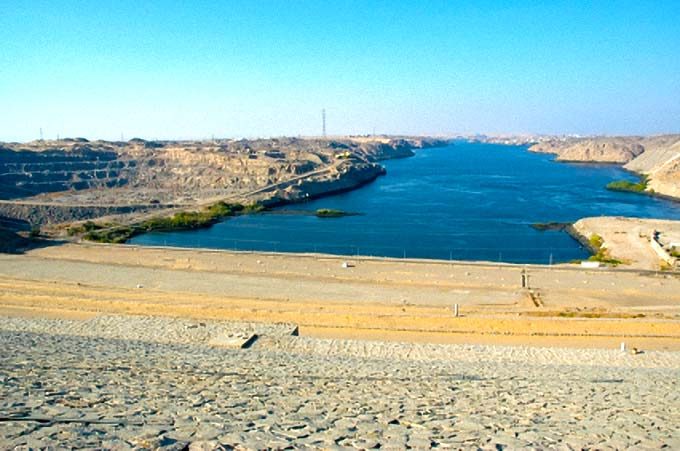The High Dam at Aswan is one of the most impressive feats of engineering design in the whole of the African continent. Construction on the High Dam began in 1960 with the view to it being a replacement for the already existent Low Dam which was built by the British from 1889-1902. The initial design of this Dam was found to be inadequate and the Dam itself was raised in two stages. The Dam almost overflowed in 1946 and it was then decided that rather than build a third extension to it, a new Dam 6km up river would be built. The former Dam is still there to this day and is traversed in order to drive up to the new Dam.
Without impediment the River Nile would flood each year during summer, as waters from East Africa flowed down the river as they did in ancient times. These floods brought nutrients and minerals that made the soil around the Nile fertile and ideal for farming. As the population along the river grew, there came a need to control the flood waters to protect and support farmland and cotton fields. In a high-water year, the whole crop may be entirely wiped out, while in a low-water year there was widespread drought and famine.
The first stage of construction on the High Dam was finished in 1964. The reservoir began filling in 1964 while the dam was still under construction and first reached capacity in 1976. It was during the flooding of the reservoir in the 1960’s that UNESCO first became concerned about the impact the Dam was having on some of Ancient Egypt’s monuments. Sites were surveyed and excavated and 24 major monuments were moved to safer locations including the Sun Temple at Abu Simbel.
The Aswan High Dam is 3,830 m in length, 980 m wide at the base, 40 m wide at the crest and 111 m tall. It contains 43 million m³ of material. At maximum, 11,000 m³ of water can pass through the dam every second. There are further emergency spillways for an extra 5000 m³ per second and the Toshka Canal links the reservoir to the Toshka Depression. The reservoir, named Lake Nasser, is 550 km long and 35 km at its widest with a surface area of 5,250 km² and holds 111 km³.
Damming the Nile has caused a number of environmental and cultural issues. It flooded much of lower Nubia and over 90,000 people were displaced. Lake Nasser flooded valuable archaeological sites such as the fort at Buhen. The silt which was deposited in the yearly floods, and made the Nile floodplain fertile, is now held behind the dam. Silt deposited in the reservoir is lowering the water storage capacity of Lake Nasser. Poor irrigation practices are water-logging soils and bringing salt to the surface. The dam has also had an impact on the Mediterranean Sea with less nutrients making it through the dam walls and thus having a negative effect on marine life in the eastern basin of the Mediterranean.
It is believed that if the Dam were to be destroyed, then the whole of the Nile Valley would be flooded in less than a day.
The Dam at Aswan can be visited on the way to or on the way back from Abu Simbel, and a visit there can also be combined with a trip to the Philae Temple.













